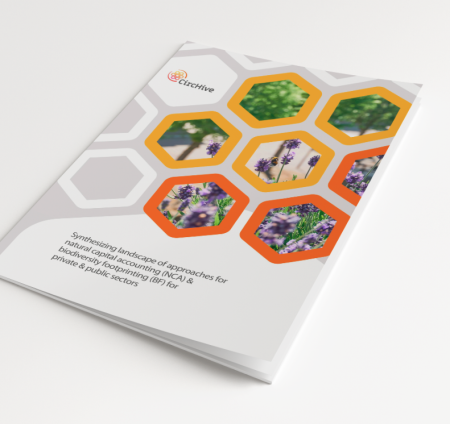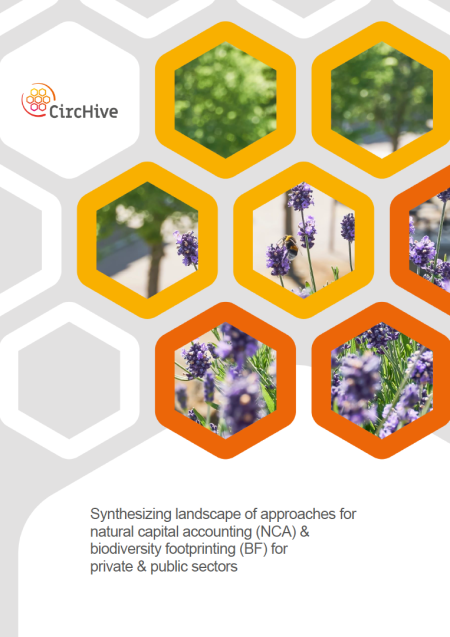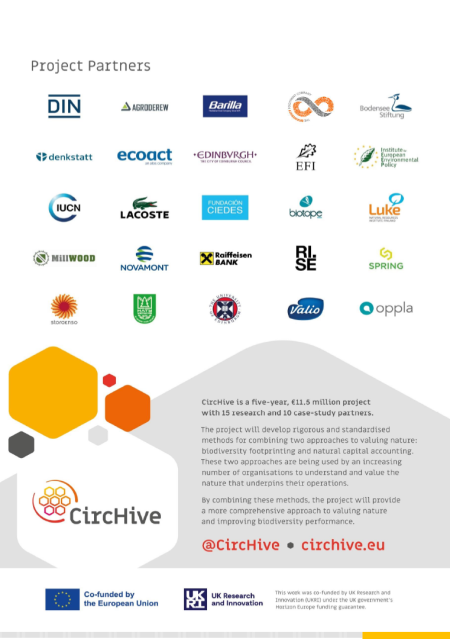
Resource description:
The report is divided into six main chapters. The report starts with three background chapters, providing the reader an overview of terms and definitions, followed by current biodiversity trends in the business environment, and initiatives in the field of NCA and BF.
In the next sections, we present the results from CircHive’s methods mapping (reviewing existing methods for BF and NCA), and tool screening (screening existing tools related to biodiversity assessments), and finally we present results from the surveys and interviews with our case study partners.
There is an evident need for accurate, science-based methods to assess biodiversity impacts resulting from human activities. In recent centuries, species extinction has occurred at a significantly accelerated rate, ranging from 10 to 100 times higher than the average rate observed over the past 10 million years. We are currently experiencing the sixth mass extinction in the 4.6 billion years-long life of the Earth.1 Looking at the surface of the earth, more than 77% of land (excluding Antarctica) and 87% of the ocean has been modified by the direct effects of human activities.2 This transformation is already so wide that it threatens the important buffering capacity of nature against the effects of climate change and other human impacts.
The ongoing global biodiversity loss calls for the worlds’ companies and institutions, in all sectors, to mitigate their negative impacts. This requires standardized methods for assessing biodiversity footprints (BF) for products, services and exploitation projects. Today, there are a rising number of suggested methods with different scope, which are built on different datasets, have different geographical and sectoral coverages and more3,4. Most are based on three different approaches: (1) Life Cycle Assessment (LCA), (2) Natural Capital Accounting (NCA) and (3) Input-output (I/O) models. The aim of this report is to present opportunities and restrictions of the three different approaches for BF assessments.
This report is the deliverable of Task 2.1 of the EU Horizon project CircHive5. The report is divided into six main chapters. The report starts with three background chapters, providing the reader an overview of terms and definitions (2), followed by current biodiversity trends in the business environment (0), and initiatives in the field of NCA and BF (4). In the next sections, we present the results from CircHive’s methods mapping (reviewing existing methods for BF 2 and NCA) (5), tool screening (screening existing tools related to biodiversity assessments) (6), and finally we present results from the surveys and interviews with our case study partners (7).
The review of Task 2.1 forms a basis for the integration, or at least to find connection between, NCA, LCA, and I/O approaches to create one holistic approach in Task 2.2. Even if the approaches would be used independently, it is important to understand the differences, strengths, and weaknesses of the different approaches, to identify the critical risks for the biodiversity assessment in question, and to use the most suitable method accordingly.
Author/Contact:
- Natural Resources Institute Finland (Luke)
Partners:
- The Biodiversity Footprint Company
- RISE Research Institutes of Sweden
- EcoAct
- Biotope
- International Union for Conservation of Nature (IUCN)
- Bodensee Stiftung
- denkstatt Bulgaria
- European Forest Institute (EFI)
- Ukrainian National Forestry University (UNFU)
- Institute for European Environmental Policy (IEEP)
- DIN Deutsches Institut für Normung
Publisher:
Bhattarai, I. et al. (2024). Synthesizing landscape of approaches for NCA and BF for private and public sectors. Deliverable 2.1 under Horizon Europe project CircHive.

